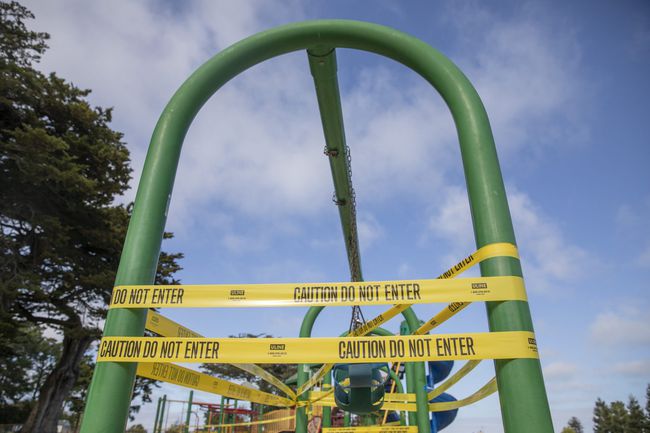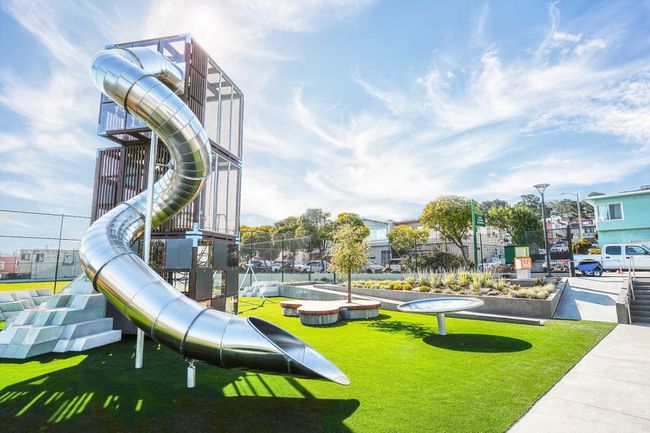Many families across the United States do not have access to safe public parks. According to data from the Trust for Public Land, 100 million Americans, including 28 million children, do not have a park within a 10-minute walk of their home.
Families who don't live within walking distance of a park have fewer opportunities to get outside, connect with friends, and exercise—and that's a problem.
Green spaces are vital to families’ mental health and children’s development. Studies show that getting outside can lower stress hormones, boost concentration, promote better sleep, and help alleviate depression and anxiety. For children, outdoor play opportunities also help develop motor skills and can even boost academic performance.
"The science supports that people need to be able to get outdoors," says Diane Regas, president and CEO of the Trust for Public Land.
But sometimes, just having a park in the neighborhood isn’t enough. Many public parks and playgrounds across the country are falling into disrepair, rendering them unusable or even dangerous. According to the 2021 National Recreation and Park Association Agency Performance Review, many park and recreation agencies are forced to delay needed park repairs due to budget limitations. This results in aging park infrastructure. Everything from drainage systems and sidewalks to bathrooms and playground equipment can quickly become unusable if maintenance is neglected.

Pushing for Change in America's Parks
The Trust for Public Land is committed to addressing these problems in cities across the country with programs to protect land and create parks, trails, and other opportunities for folks to get outside. Smaller, local non-profit organizations like the San Francisco Parks Alliance in San Francisco, and Brilliant Detroit in Detroit, have similar missions and passion for revitalizing our nation’s parks and ensuring all families have access to green spaces.
These groups are also committed to addressing the park equity gap, which describes disparities in who has access to parks. Data from the Trust for Public Land shows that in the 100 most populated U.S. cities, majority nonwhite neighborhoods have, on average, access to 44 percent less park acreage than majority white neighborhoods. Low-income communities have access to 42 percent less park acreage per person on average than high-income communities.
This year, San Francisco was recognized as the sixth-best city in the nation for park access, acreage, investment, amenities, and equity. But organizations are still hard at work improving the city’s parks.
"San Francisco is still working very much on bringing the city up to equal standing as far as our parks and playgrounds," says Sonia Gonzalez Banks, director of external affairs, marketing, and development at the San Francisco Parks Alliance.
One local initiative is Let’s Play SF!, a partnership between the San Francisco Parks Alliance and the San Francisco Recreation and Park Department to transform 13 of the city’s most timeworn parks.


With an eye on closing the park equity gap, Let's Play SF! prioritized parks in low-income or marginalized neighborhoods for revitalization. "We believe everyone should have access to safe welcoming, green places outside," says Gonzalez Banks.
The Let’s Play SF! Team also prioritized parks in kid-dense neighborhoods and redid every city park that still had chromated copper arsenate, a potential harmful chemical preservative containing chromium, copper, and arsenic that protects wood from rotting, on its equipment. Of the 13 parks selected for revitalization, eight have been completed thus far. The remaining five are scheduled for completion by 2022.
Local parent Matthew Gubiotti lives near West Portal Playground, one of the 13 parks selected for revitalization through Let’s Play SF! He participated in the revitalization project through a neighborhood group of park advocates called Friends of West Portal Playground. Gubiotti says that together the organizations and local volunteers transformed West Portal Playground from a site that had fallen into “terrible disrepair” into a beloved gathering place for the entire neighborhood.
Gubiotti joined the effort to make a difference in his community. "Having chosen to raise our children in San Francisco, I wanted to do our part to help revitalize one small corner of our neighborhood," Gubiotti says. "It brings me joy to see [the new park] getting such heavy traffic."
Even Small Parks Make a Difference
Across the country in Detroit, non-profit organization Brilliant Detroit is also working to close the local park equity gap. The organization focuses on building pocket parks in underserved urban neighborhoods as part of its broader mission to create "kid success neighborhoods"—areas where kids and families have everything they need within 20 minutes of where they live.
"The park system is an important piece of creating what I see as an ecosystem, where kids and families have a chance—so that zip codes don't predict whether a child's future is bright or not," says Cindy Eggleton, co-founder and CEO of Brilliant Detroit.
Unlike the larger 1.9-acre West Portal Park in Gubiotti's San Francisco neighborhood, a pocket park might be no larger than a quarter of an acre or about the size of a couple of house lots. But these smaller parks are just as beneficial to their communities.
Studies show that access to pocket parks supports physical and mental health and provides social benefits as a gathering space. Particularly in Detroit, Eggleton says that local parks serve as needed gathering spaces where kids can practice social skills and families can come together to strengthen community relationships.
Brilliant Detroit has started work on four pocket parks thus far, and the organization has plans to create 24 of them by 2024.
What Parents Can Do to Help
At every step, these organizations have found that community involvement is vital to successful park revitalization. "Working with communities leads to the highest quality, the most vibrant, the most well-used and well-loved parks," says Regas.
While underinvestment is a major contributor to lack of parks or park disrepair, Regas says that investment alone won't solve the problem. "We do need to invest," she says, "But what makes a good park is a park that is loved by the community around it. That dynamic changes everything."
For parents or community members interested in joining a park revitalization project in their neighborhood, finding a local community group like Friends of West Portal playground is an excellent place to start. If your neighborhood doesn't have a local coalition, make one.
"Be noisy and persistent," suggests Gubiotti. "Be an advocate for the change you want to see, [and] find city stakeholders and partner with them to grow a coalition."
Eggleton agrees: "You should feel like you can demand [action] from your cities." Parents also shouldn't be afraid to start small. Every step toward ensuring the kids in your community have access to a park, says Eggleton, "really, really, really does matter."
